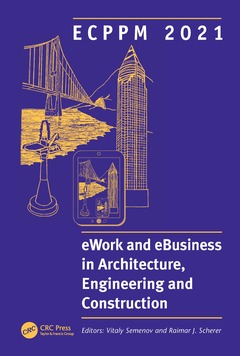Description
ECPPM 2021 - eWork and eBusiness in Architecture, Engineering and Construction
Proceedings of the 13th European Conference on Product & Process Modelling (ECPPM 2021), 15-17 September 2021, Moscow, Russia
Coordinators: Semenov Vitaly, Scherer Raimar J
Language: English
Subjects for ECPPM 2021 - eWork and eBusiness in Architecture...:
Keywords
IFC; BIM Model; AEC Industry; Semantic Information; Digital Twins; CPSs; Point Cloud; IFC Format; BIM Application; Business Processes; Point Cloud Data; FM Industry; Vice Versa; VDC; MVD; SPARQL Query; Common Data Environment; BIM Implementation; BIM Tool; Literature Review; Owl; BIM Environment; IFC Data; Asp; IFC Standard
· 17.4x24.6 cm · Hardback
Description
/li>Contents
/li>Readership
/li>Biography
/li>
eWork and eBusiness in Architecture, Engineering and Construction 2021 collects the papers presented at the 13th European Conference on Product and Process Modelling (ECPPM 2021, Moscow, 5-7 May 2021). The contributions cover a wide spectrum of thematic areas that hold great promise towards the advancement of research and technological development targeted at the digitalization of the AEC/FM (Architecture, Engineering, Construction and Facilities Management) domains. High quality contributions are devoted to critically important problems that arise, including:
- Information and Knowledge Management
- Semantic Web and Linked Data
- Communication and Collaboration Technologies
- Software Interoperability
- BIM Servers and Product Lifecycle Management Systems
- Digital Twins and Cyber-Physical Systems
- Sensors and Internet of Things
- Big Data
- Artificial and Augmented Intelligence in AEC
- Construction Management
- 5D/nD Modelling and Planning
- Building Performance Simulation
- Contract, Cost and Risk Management
- Safety and Quality
- Sustainable Buildings and Urban Environments
- Smart Buildings and Cities
- BIM Standardization, Implementation and Adoption
- Regulatory and Legal Aspects
- BIM Education and Training
- Industrialized Production, Smart Products and Services
Over the past quarter century, the biennial ECPPM conference series, as the oldest BIM conference, has provided researchers and practitioners with a unique platform to present and discuss the latest developments regarding emerging BIM technologies and complementary issues for their adoption in the AEC/FM industry.
1. Prof. Dr. Vitaly A. Semenov has headed the Department of System Integration and Multi-Disciplinary Applied Systems at the Ivannikov’s Institute for System Programming of the Russian Academy of Sciences since 2015. His main research interests focus on model-driven software engineering methodologies and CASE toolkits for creating advanced digital platforms and integrated systems that meet the requirements of multi-functionality, multi-modality, scalability, interoperability, portability and deployment in heterogeneous environments. He has led more than 25 Russian and international R&D projects and has published 150 articles on fundamental topics of software engineering, data management, computer graphics, and operations research. He is a Professor for computer science at the Moscow Institute of Physics and Technology, and the Higher School of Economics both leading Russian State Universities. For more than 20 years he has been giving lectures on software and information visualization. Emerging BIM technologies are of particular attention. From 2007 to 2017 he directed the development of 4D modeling and planning system at Synchro Software Ltd. He developed innovative methods for spatial-temporal project planning, near-optimal project scheduling, effective rendering of large pseudo-dynamic scenes, and semantic reconciliation of replicated data, which made it possible to provide competitive advantages of the system. Currently, it is a popular software product that has been successfully used by hundreds of companies around the world to visually plan and manage complex construction projects and large infrastructure programs.
2. Prof. Dr.-Ing. Raimar J. Scherer is Senior Professor at the Institute of Construction Informatics at the Technical University Dresden responsible for the research. He was heading the Institute from 1994-2017. He has more than 35 years of experience in construction IT, including 7 years as full professor for CAD/CAM and structural re




